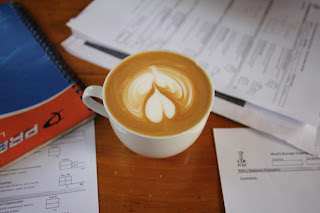
Welcome to Great Lakes Coffee - the honorary Consulate of Greece.
After eating a bit too much barbecue and partying together in Houston this past April, Andy invited me to visit his coffee factory the next time I was in Kampala (you know, because I always just happen to swing out to Africa).
And since I was in Kampala, I gave him a ring and off we were running in a Euro-spec Nissan Patrol careening through the streets of Kampala off to some far-flung place on the eastern side of the city, past rutted roads, mud huts and sinfully gorgeous gated mansions to this industrial section where I wondered how anyone navigated the "road" without a four wheel drive truck or SUV.

Where the women hand sort for defects.
Drive up and you face a gated wall that's simply ominous and forbidding. Until the armed guard with the Ak-47 swings the gate open with a friendly "You're very most welcome!"
Africa: Situation Normal.
Once inside the high, concrete walls, I'm reminded of my cousins rice mill in the Philippines. Large, flatbed trucks wait to haul away container loads of coffee and some kind of mill towers above all else.

A mosque for the Muslim workers.
Our tour begins with the sorting room. Here dozens of women sit on the floor, spread out with a bag of green coffee in front of them. Each of the women sit there sorting the coffee and picking out the bad beans. Those go into a hopper where they'll evidently be sold to Lavazza or Illy or Folger's, or any of the dozens of coffee companies looking for coffee of any quality - so long as it's priced below the C-Market.
For the women, it's a great way to make money and socialize. They sit in the large room, openly discussing the days gossip. Who's doing what to whom, and so on. Showing me a wooden desk that looks like an oversized cigar rolling table, Andy tells me that he once tried to create these work stations where the women would sit and sort. It would be more comfortable and more efficient, allowing these women (who are paid by the bag) to work faster and earn more.
Problem is that these workstations ended up being five feet high and when seated, the bin would obscure the women's view from each other, thus ending the social interaction that they enjoy more than cranking out another bag a day. The one model stands lonely in the space, a monument reminding the women that this is about sorting quality coffee AND discussing what that crazy muzungu lady must have been thinking wearing that outfit to church.

Laser sorting green coffee.
From there it's past the Mosque built specifically so that Muslim workers would have a place to worship and into the processing room where thousands of pounds an hour can be mechanically dried, hulled, sorted and bagged. It's a large and impressive operation with laser sorters that divide the beans at incredible speed.
Next to the processing area is the arrival storage area where the room is nearly packed to the ceiling with green coffees fresh from the fields. The harvest is starting to peak here in Uganda and we're seeing the greatest volume right about now.

Reaching the peak of harvest.
After a tour of the offices to meet the company principals (Dad, uncle, brother and Kat), I'm whisked into the lab where the fun really will begin. Andy, Corey and Emma have set up an 11 sample cupping for me to taste the latest crop arrivals along with some interesting specimens from the DRC (Democratic Republic of the Congo) and a freakingly interesting natural processed robusta.
Awareness of Ugandan coffees is very low, with most people only knowing or hearing about Ugandan Bugisu. According to Andy, coffees from this Bugisu region can be very good - especially the select stuff from Mount Elgon. The problem with Bugisu is similar to that of Kona in Hawaii. Coffees from other parts of Uganda, which may be interesting on their own, are trucked across the country to be blended with coffees from the Bugisu region to become Uganda's "Bugisu" coffee.

Cupping New Crop arrivals.
Happily, Andy and company are forging ways to preserve the unique characters of the growing regions and develop a specialty market for these coffees. I'm interested in tasting these coffees and bringing them back to the United States.
Despite (or maybe because of) the fact that we buy and sell some of the best coffees available on the market at Spro, my personal exposure to the many cupping defects out there really is quite limited. By the time we receive our green or roasted coffees, they've already gone through a multi-stage process of cupping and vetting. Here, we're tasting the stuff as it's coming from the field and anything goes.

Screening 320 bags (container load) with my face.
One cupping sample (out of the five) immediately smelled of boiled peanuts when dry and wet potatoes when wet. There's that potato fungus right there. Sadly, while it was interesting to actually cup a coffee from the DRC, the coffee itself wasn't quite what we were looking for.
There were, however, several samples that I found really intriguing and I'm planning on following these coffees through the harvest to see exactly how they're going to shape up in the coming weeks.



